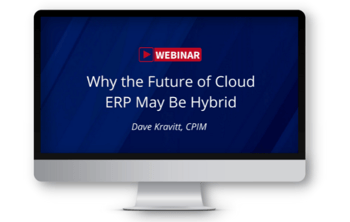 The “cloud” always seems to be a hot topic in ERP-related discussions these days–and for good reason! A cloud implementation that is well-matched to a business’s requirements can offer an exceptional blend of performance, affordability, and operational agility.
The “cloud” always seems to be a hot topic in ERP-related discussions these days–and for good reason! A cloud implementation that is well-matched to a business’s requirements can offer an exceptional blend of performance, affordability, and operational agility.
But not all cloud implementations are created equal! In fact, the most effective cloud implementation for a specific business’s requirements may still involve substantial on-premise infrastructure. In this blog, we take a look at the pros and cons of SaaS, PaaS, and Hyrbid approaches to cloud ERP.
The discussion below summarizes the material presented in our latest webinar (you can watch it here).
Cloud ERP: SaaS, PaaS, or Hybrid?
It can be helpful to categorize cloud ERP deployments according to their basic architecture:
- Software-as-a-Service: software vendors host a solution on their own infrastructure and license it to the user, typically via a subscription agreement.
- Platform-as-a-Service: an enterprise’s current software is migrated to a vendor’s DC/infrastructure.
- Hybrid: legacy ERP software is kept on premises and integrated with cloud point-based solutions to meet specific business needs.
Pros and Cons of a SaaS ERP Approach
These implementations are typically new ERP solutions, completely replacing an organization’s existing ERP software. There may be good business reasons for this switch. Legacy ERP software may no longer fulfill core business requirements, no longer be supported, or the requisite skillsets may no longer be readily available on the market.
Key Benefits of a SaaS Approach include:
- Fast implementation.
- Cost savings: no upfront infrastructure investment is required.
- In many cases, SaaS ERP solutions offer a modern UI that can help increase end-user buy-in.
- A depth of infrastructure and data center services that most organizations would be hard-pressed to match internally.
- Outstanding scalability.
Potential Drawbacks of a SaaS Approach include:
- The organization will need to navigate all the risks and disruptions associated with switching ERP software.
- It may cost more over time as license costs catch up to the upfront capital costs of infrastructure.
- Potentially limited customizations and other enhancements which can be a source of embedded institutional knowledge and competitive advantage which the organization has carefully built over years.
- Risk of internet failure (though today’s DC’s are more resilient than ever, and the likelihood of a failure is very low).
Pros and Cons of a PaaS ERP Approach
A PaaS approach can make sense if the ERP software is still fulfilling its core requirements, but the business would like to benefit from the flexibility of the cloud. This case study covering our support for Intertape Polymer Group (IPG) provides a more detailed look at a carefully tuned PaaS migration strategy.
Key Benefits of a PaaS Approach include:
- No need to learn a new ERP, change your business process to match it, etc.
- A simplified migration process–simply move your software to the cloud LPAR and make the necessary network changes.
- The same infrastructure and scalability advantages are associated with a SaaS approach.
Potential Drawbacks of a PaaS Approach include:
- As with a Saas approach, the risk of internet failure is small but real.
- The organization no longer has the same level of control over its infrastructure.
Pros and Cons of a Hybrid ERP Approach
A hybrid ERP can be a great option when ERP software is still fulfilling core business requirements but the organization could benefit from enhancements with new functionality, or integration with other cloud-based applications. Many organizations approach this strategy by implementing back-office systems, or “systems of record,” onsite, and operational functions, or “systems of engagement” through cloud point functions. PSGi’s customers successfully make use of cloud point functions including pricing, master data maintenance, warehouse management, and business intelligence/analytics.
Key Benefits of a Hybrid Approach include:
- Cloud integration allows for addressing pain points quickly, with modern industry best practices.
- Avoid the disruption of unnecessarily migrating to a new ERP.
- Allows for the maintenance of centralized IT governance and physical control of core infrastructure.
Potential Drawbacks of a Hybrid Approach include:
- Potentially more complex data integration requirements.
- Disjointed user interface between ERP and point applications.
- The same risks of internet failure are associated with all cloud ERP strategies.
Which Cloud ERP strategy is right for your organization?
In our experience working with all of the implementations outlined above, the best option will depend on whether your existing ERP software is successfully meeting your core needs. If existing ERP software is not meeting your core business requirements, upgrading to a new system through a SaaS arrangement may be the best path forward. However, if your existing ERP continues to deliver strong value, the risk and disruption of moving to a new ERP may not be worth it. The choice between a hybrid or PaaS approach will depend on whether the organization needs new point-based functionality.
For a deeper discussion of the issues discussed above, watch our webinar here. Or, if you are ready to discuss your ERP challenges with the PSGi team, you can reach out using the button below.



